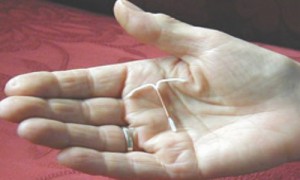In the Atlantic, Jacoba Urist writes on the controversy over the approximately 37% of publicly-funded School-Based Health Centers which offer teens contraception, and 11% of which provide long-acting reversible contraceptives like intrauterine devices. It’s mostly an informative piece laying out the arguments and the details on how policies vary, but it definitely leaves Urist’s readers with the impression that this is a great idea:
Reports have outlined remarkable success in Colorado, for example, where adolescents and low-income women were offered free IUDs or contraceptive implants—and teen pregnancy plummeted by 40 percent […] Today, teen pregnancy rates nationwide—and across racial and ethnic groups—sit at historic lows. What’s behind the progress? According to a 2014 Guttmacher Institute analysis, teens aren’t having less sex; they’re using more contraception.
As always, the complete picture is quite different.
National Review domestic-policy analyst Callie Gable took a closer look at the Colorado study and found the hype wildly overblown—it was singling out part of a larger decline that preceded the program, ignored that a decline 85% as large also occurred in counties without the program, failed to control for major population differences in the counties, and compared counties as wholes rather than studying comparable women in and out of the program. In addition, while focusing on abortion rates, it didn’t “cover data on discontinuance rates, reinsertion rates, changes in STI transmission, or on many other factors that are important.”
 Meanwhile, eminent abortion researcher Michael New reviewed Guttmacher’s report and found it severely lacking. It cherry-picked a two-year study of 18- and 19-year-olds, attributing the decline to contraceptives while ignoring numerous studies finding 1) that teens are indeed having less sex, 2) that a “very small percentage” of teens use long-acting reversible contraceptives, and 3) that Guttmacher’s own prior research admits the role of parental involvement laws in teen abortion declines.
Meanwhile, eminent abortion researcher Michael New reviewed Guttmacher’s report and found it severely lacking. It cherry-picked a two-year study of 18- and 19-year-olds, attributing the decline to contraceptives while ignoring numerous studies finding 1) that teens are indeed having less sex, 2) that a “very small percentage” of teens use long-acting reversible contraceptives, and 3) that Guttmacher’s own prior research admits the role of parental involvement laws in teen abortion declines.
As Live Action regular readers know, New has cited a great deal of research finding that contraceptive distribution not only fails to reduce teen pregnancy but actually increases it. So have we.
It may seem counterintuitive, but once you know what a non-factor lack of “access” really is, what’s going on begins to clear up. It isn’t that contraception doesn’t prevent any pregnancies, but that that it’s already preventing pretty much all of them it’s ever going to.
Contraception is plentiful and affordable enough that a policy of pouring more into the country doesn’t address the behavioral reasons why unwanted pregnancies still happen; it just encourages more of the behavior that causes them in the first place.
(By the way, addressing that behavior via abstinence education is highly effective, but those most loudly claiming contraceptive opponents must not care about teen pregnancy tend not to want to even consider it. Curious, that. It’s almost as if the real goal is promoting one of Planned Parenthood’s top business or a radical vision of youth sexual values…)
To parental-rights concerns, Urist assures us that this doesn’t necessarily mean they’ll do so behind Mom and Dad’s backs – even though 21 states let them implant IUDs without parental consent and in Washington, for instance, the state’s Take Charge program allows minors to apply without billing it to their parents’ insurance.
She also neglects to mention that she’s talking about an abortifacient method of “contraception,” which kills an already-conceived embryo by blocking implantation, which throws a major wrench into the whole justification of preventing teen abortions.
 Nor does she address the matter of IUDs’ health risks. If we’re talking about products that carry a potentially fifty-fifty chance of ectopic pregnancy, that haven’t even undergone clinical trials with minors, that increase the odds of pelvic inflammatory disease, and have been linked to over seventy thousand complaints to the FDA since 2000, how is it even a debate that parents need the lion’s share of the decision-making power here? Especially among the same education bureaucrats that won’t dispense aspirin or allow soda or candy on health grounds?
Nor does she address the matter of IUDs’ health risks. If we’re talking about products that carry a potentially fifty-fifty chance of ectopic pregnancy, that haven’t even undergone clinical trials with minors, that increase the odds of pelvic inflammatory disease, and have been linked to over seventy thousand complaints to the FDA since 2000, how is it even a debate that parents need the lion’s share of the decision-making power here? Especially among the same education bureaucrats that won’t dispense aspirin or allow soda or candy on health grounds?
But the central fallacy of Urist’s argument, and the whole “comprehensive” sex education project, is betrayed when she talks up the benefits of IUDs because “kids don’t have to remember to take it every day,” and “a holistic, prevention-based strategy that encourages students to make healthy choices for their long-term well-being.”
If remembering to take a pill is too much to expect of someone, it just might be a sign that they’re not yet capable of exercising even a fraction of the responsibility proportionate to the life-changing, life-creating potential of sex. And having sex before even being able to support yourself, let alone a partner and child, is inherently and objectively not a “healthy choice for long-term well-being.”
Dispensing contraceptives to teenagers is terrible policy for children’s futures. The educational mindset that makes it conceivable in the first place spells even more danger.







